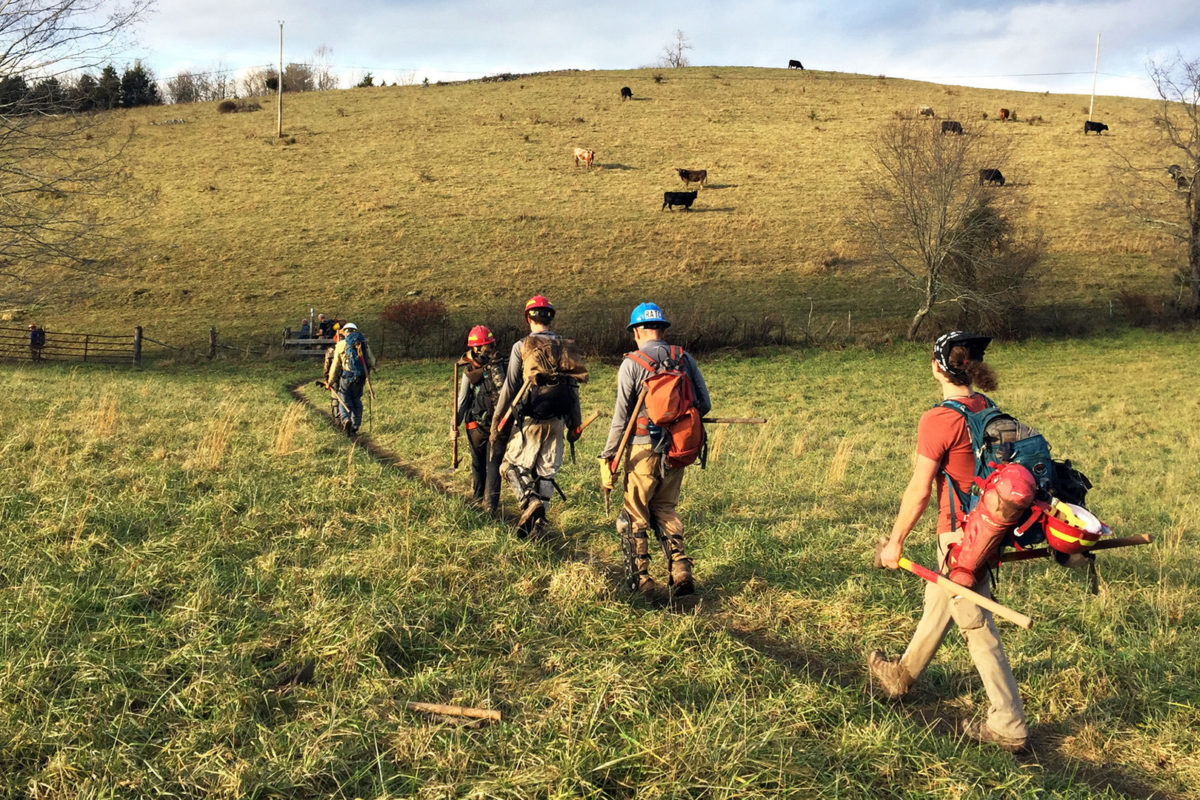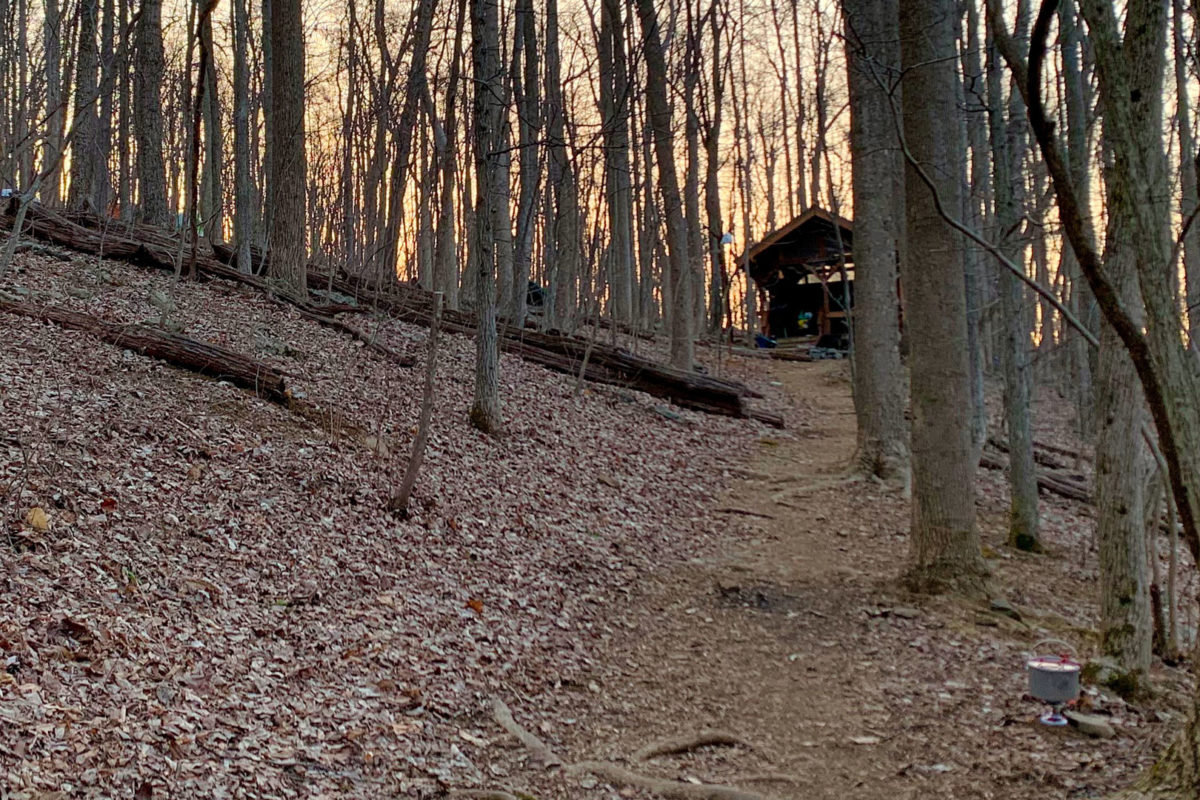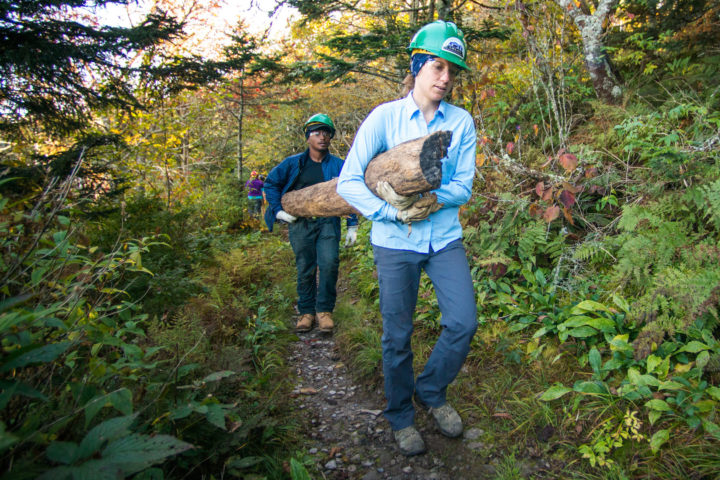A.T. Management
Trail and Facilities Management
Trail and Facilities Overview
The Appalachian National Scenic Trail (A.T.) is managed as a simple footpath, following characteristics and qualities identified in the A.T. Comprehensive Plan, adhering to subsequent policies published by the Appalachian Trail Conservancy (ATC), and following guidance found within A.T. partner Local Management Plans.
The sections below address Trail management and maintenance, overnight facilities, and visitor use management.
A full list of the Appalachian Trail Conservancy’s policies on Conservation and Trail Management can be viewed here: Conservation and Trail Management Policies | Appalachian Trail Conservancy

Key A.T. Management Documents

Project Management Resources

Annual work planning between local A.T. clubs and land managers sets the stage for work in the months and years ahead. Work beyond routine maintenance requires review. Start with a National Park Service (NPS) Appalachian National Scenic Trail park office (APPA) project proposal form to begin the necessary review for National Environmental Protection Act Review, as well as Section 106 and Historic Preservation Act Review.
Accomplishments on the A.T. such as the addition or removal of Trail features like steps or waterbars, or changes to structures, such as the replacement of a shelter roof, should be reported to the Appalachian National Scenic Trail using the Trail Facilities Update Forms found below. Updates using these forms are reflected annually on the A.T. Facility Web Map App.
Background Information and Training on Trail Asset Inventory
Facility Inventory Update Process
ATC, NPS-APPA, and the Appalachian Trail-maintaining clubs have undertaken a Trail-wide inventory to count every location and feature along the A.T. corridor. This information helps us prioritize limited funds and resources toward their continued care. Improving project development and cost estimation, tracking, and reporting will also make the Appalachian National Scenic Trail more competitive for federal funds.
To keep the information current, work completed by ATC and Trail club volunteers needs to be reported.
Questions and comments should be directed to APPA_Facilities@nps.gov or your ATC regional office.
Facility Asset Inventory Process Presentation 2022 ![]()
Inventory Update Process Cover Letter (Version 2.0) ![]()
Inventory Update Process Flow Chart ![]()
Video guides for the interactive map and online update forms (YouTube)
Inventory Update Forms
The forms are to be used to report completed improvements and alterations, not for planning purposes.
Questions and comments should be directed to APPA_Facilities@nps.gov or your ATC regional office.
Option 1) Navigate to the APPA Facility WebApp to open an online form with FMSS and GPS coordinate data pre-filled.
Option 2) Complete an offline form:
A.T. Bridge Update Form (Version 2.0) ![]()
A.T. Designated Campsite Update Form (Version 2.0) ![]()
A.T. Parking Area Update Form (Version 2.0) ![]()
A.T. Privy Update Form (Version 2.0) ![]()
A.T. Road Inventory Form (Version 2.0) ![]()
Viewpoint Update Form ![]()
A.T. Shelter Inventory Update Form (Version 2.0) ![]()
A.T. Side Trail Update Form (Version 1.1) ![]()
A.T. Treadway Update Form (Version 1.1) ![]()
General Treadway Management

- Appalachian Trail Design Construction and Maintenance
- Appalachian Trail Fieldbook – coming soon!
- USFS Trail Construction and Maintenance Notebook – 2025

- Increasing Opportunities for Access on the Appalachian Trail: A Design Guide (2007)

- USFS Trail Accessibility Guidelines (FSTAG)
 and other USFS Accessibility Resources
and other USFS Accessibility Resources
- Access Board Resources for Outdoor Developed Areas
 : A summary of accessibility standards for federal outdoor developed areas.
: A summary of accessibility standards for federal outdoor developed areas.

ATC Policies on General Treadway Management
Accessibility Policy (LMPG) ![]()
Trailheads and Parking Policy (LMPG) ![]()
Relocations Guidance (LMPG) ![]()
Side and Connecting Trail Policy (2022) ![]()
Advertising in the A.T. Corridor Policy (2001) ![]()
Wilderness Policy (1991) ![]()
Trail Signs Policy (1995) ![]()
Trail Design, Construction, and Maintenance Policy (1979) ![]()
Stream Crossings and Bridges Policy (2011) ![]()
Stream Crossing Infrastructure Planning Guidance (2024)![]()
Special Use Permits Guidance (1983) ![]()
Managing the Trail for a Primitive Experience Policy (1995) ![]()
Litter and Graffiti Policy (1984) ![]()
Agricultural Use on A.T. Corridor Lands Policy (1996) ![]()
Sustainable Trail Management
Dr. Jeff Marion, Dr. Jeremy Wimpey, and Johanna Arredondo performed a 5-year study on sustainable trail & camping management on the A.T. The video of their presentation is offered as a self-paced online training here.
A.T. Final Report, Best Management Practices, Review Draft ![]()
Marion-Wimpey, Sustainable Trail Design, 2017 ![]()
Aredondo et al., Modeling Areal Measures of Campsite Impacts, Under review ![]()
Eagleston-Marion, BWCA Sustainable Camping, 2017 ![]()
Meadama et al., In Press, A.T. Trail Impacts and Sustainable Mgmt, JEM, 2019 ![]()
Trailheads and Parking
Trailheads are the most visible evidence of the Trail for the general public and provide the first impression of the Trail to its visitors.
Trailhead Kiosks, 2012 Update to Trailhead Bulletin Board ![]()
Appalachian National Scenic Trail Sign Standards
This wayfinding planning resource provides information on layout, procurement, fabrication, installation, and maintenance for portal signage, interpretive kiosks, blazing, and other signage:
APPA Sign Standards Manual (2021)![]()
This 25-minute video accompanies the manual.
Side and Connecting Trails
ATC Connecting Spur, Side, Access, and Coaligned Trails Policy (2022) ![]()
The National Trails System Act makes specific reference to the formal designation of side and connecting trails as components of the National Trail System. Formal designation is the responsibility of the U.S. Secretary of Agriculture (if that trail is located within national forest proclamation boundaries) or the USDI Secretary of the Interior (on all other lands).
The following definitions of designated side and connecting trails are consistent with the legislation:
- Designated Side Trail: Any trail formally designated as such by action of the Secretary of Agriculture or Secretary of the Interior that intersects the A.T. and provides additional access to the A.T. from outside the Appalachian Trail corridor.
- Designated Connecting Trail: Any trail formally designated as such by action of the Secretary of Agriculture or Secretary of the Interior that connects the A.T. and another National Scenic, Historic, or Recreation Trail.
Other trails intersecting the A.T. do not require formal designation at the Secretarial level. They may include:
- Spur Trails: Provide passage to points of interest or Trail facilities.
- Access Trails: Typically local trails that intersect the A.T. and are formally recognized and maintained by a local Trail club or another Trail management partner. These trails may originate and travel on public land, private land, or cross both before they connect to the A.T. Often informally referred to as “side trails”.
- Coaligned Trails: Other trails that share the same treadway and protected corridor as the A.T.
Spur and Access Trails as described above are often referred to informally as “side trails” and are not intended to be an extension of the National Trails System—in other words, they are not intended as Designated Side Trails or Designated Connecting Trails, and therefore do not require action by the Secretary. However, planning for construction of any new Spur or Access trails must include the same formal review process noted above for Relocations.
Policies on Non-hiking Recreational Use
Motorized Uses Policy (LMPG) ![]()
Unmanned Aircraft Policy (2015) ![]()
Military Maneuvers Policy (1989) ![]()
Hunting Policy (1992) ![]()
Horses and Pack Animals Policy (1985) ![]()
Hang Gliding Policy (1996) ![]()
Geocaching Policy (2008) ![]()
Bicycle Use Policy (1991) ![]()
A.T. Experience and Non-Hiking Recreational Uses Policy (1997) ![]()
Trail Magic Guidance 2007 ![]()
Overnight Site Management
Care for the A.T. is guided by ATC’s published standards and companion resources from the U.S. Forest Service.
Planning and managing overnight sites relates to visitor use management, the experience of the Appalachian Trail, sanitation, food storage, and minimum impact practices by Trail planners and visitors. For overnight site work beyond routine maintenance, A.T. managers will need to submit the form A-2-Checklist-for-Overnight-Facilities in addition to the project proposal forms at the top of this page to their ATC regional office.

Remember that any changes to these types of Trail facilities should be reported through the Trail Asset Inventory Update process, detailed above.

Planning Guides for Shelters and Privies
ATC Overnight Site Planning Guidance (2023)![]()
- Instructions for the A.T. Overnight Site Facility Assessment Tool (OSFAT)

- A.T. Overnight Site Facility Assessment Tool (OSFAT)

Increasing Opportunities for Access on the Appalachian Trail: A Design Guide (2007) ![]()
USFS Trail Accessibility Guidelines (FSTAG) and other USFS Accessibility Resources ![]()
Access Board Resources for Outdoor Developed Areas: A summary of accessibility standards for federal outdoor developed areas ![]()
Additional Resources for Planning A.T. Shelters and Privies ![]()
USFS Region 8 Accessible Moldering Privy Design ![]()
USFS Region 9 Accessible Moldering Privy Design ![]()
SMHC 3-Bin Moldering Privy ![]()
Research and Training on Camping Impact Management
A.T. Resources for Sustainable Trail and Camping Management
Dr. Jeff Marion, Dr. Jeremy Wimpey, and Johanna Arredondo performed a 5-year study on sustainable trail & camping management on the A.T. The video of their presentation is offered as a self-paced online training here.
AT Final Report, Best Management Practices, Review Draft ![]()
Aredondo et al., Modeling Areal Measures of Campsite Impacts, Under review ![]()
Eagleston-Marion, BWCA Sustainable Camping, 2017 ![]()
Camping Impact Management on the A.T. (2003), Marion ![]()
Visitor Use Management
Topics in this section address permitted and non-permitted visitor activities, visitor education methods and strategies, and methods for measuring and managing visitor impacts to the biophysical, social and managerial settings that affect the hiking experience.
The Appalachian Trail is a popular place to visit, with millions of visitors to the Trail each year. Most of this is day use or short-term overnight use, but the sheer volume of users creates many management challenges. Impacts on the Trail environment are often evident along high-use sections of the A.T.: litter, unsanitary conditions, trampling, bootleg campsites, fire rings, damaged trees, and shortcutting at switchbacks are resource impacts frequently reported by ridgerunners and Trail maintainers.
Hikers also affect each others’ backcountry experience—as the number of people seeking a primitive backcountry experience increases, the potential for solitude decreases.
Resources for Visitor Use Management
Inter-Agency Visitor Use Management Council (IVUMC) Resources
Planning Guide, A.T. Community Kiosks ![]()
Organized Group Use Policy ![]() (2015)
(2015)
Organized Group Management Manual – First Edition ![]() (2016)
(2016)
See also content above related to A.T. experience, trailheads, and overnight sites.
A full list of the Appalachian Trail Conservancy’s policies on Conservation and Trail Management can be viewed here: Conservation and Trail Management Policies | Appalachian Trail Conservancy
Discover More

What does Cooperative Management mean?
Cooperative Management
The A.T. is cared for by public and private partners working together to achieve common goals for the Trail. This unique partnership relies on civic engagement from people within A.T. Maintaining Clubs, the ATC, and local land managers to communicate, collaborate, and carry out the essential management of the A.T.

Policies Guiding a Cohesive A.T. Experience
Policies
A unified approach to the care of the A.T. takes coordination and cooperation among a number of partners. Learn how the ATC works with Cooperative Management Partners to define policies that bring consistent management to 8 national forests, 6 national park units, 14 states, and numerous state and local jurisdictions.
